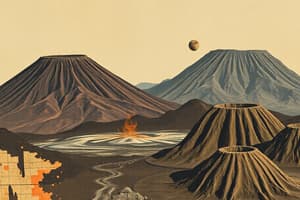Podcast
Questions and Answers
Which type of volcano is formed by the accumulation of lava that oozes out?
Which type of volcano is formed by the accumulation of lava that oozes out?
- Shield volcano (correct)
- Stratovolcano
- Composite volcano
- Cinder cone
What determines the eruptive behavior and cone shape of a volcano?
What determines the eruptive behavior and cone shape of a volcano?
- Viscosity of the magma (correct)
- Elevation of the volcano
- Composition of the surrounding rocks
- Proximity to tectonic plate boundaries
Which of the following is NOT one of the six most active volcanoes in the Philippines?
Which of the following is NOT one of the six most active volcanoes in the Philippines?
- Mayon
- Pinatubo
- Hibok-hibok
- Mount Merapi (correct)
How are active volcanoes classified according to PHIVOLCS?
How are active volcanoes classified according to PHIVOLCS?
Which type of volcano is characterized by steep slopes and alternating layers of lava flows and pyroclastic materials?
Which type of volcano is characterized by steep slopes and alternating layers of lava flows and pyroclastic materials?
What is the primary factor that determines the viscosity of magma?
What is the primary factor that determines the viscosity of magma?
How are inactive volcanoes classified according to PHIVOLCS?
How are inactive volcanoes classified according to PHIVOLCS?
Which type of volcano is typically formed by the accumulation of pyroclastic materials and has a conical shape?
Which type of volcano is typically formed by the accumulation of pyroclastic materials and has a conical shape?
What is the primary factor that determines whether a volcano will erupt explosively or effusively?
What is the primary factor that determines whether a volcano will erupt explosively or effusively?
Which of the following is NOT a type of volcanic cone shape?
Which of the following is NOT a type of volcanic cone shape?
Flashcards are hidden until you start studying
Study Notes
Volcanoes
- A volcano is a natural opening in the Earth's surface where molten rocks, hot gases, smoke, and ash are ejected.
- Volcanoes are classified based on their records of eruption or activity, cone shape, and style of eruption.
Volcanoes in the Philippines
- The Philippines has around 300 volcanoes, with 23 identified as active and the rest as inactive or dormant.
- The Philippine Institute of Volcanology and Seismology (PHIVOLCS) system classifies volcanoes based on their records of eruption.
- Volcanoes with a record of eruption within the last 600 years or that erupted 10,000 years ago are considered active.
- Volcanoes with no record of eruption or that have not erupted for the last 10,000 years and are being changed by weathering and erosion are considered inactive.
- The six most active volcanoes in the Philippines are Mayon, Hibok-hibok, Pinatubo, Taal, Kanlaon, and Bulusan.
Types of Volcanic Cones
- Shield volcanoes are formed by the accumulation of lava that oozes out from the volcano, resulting in a broad, slightly domed structure.
- Examples of shield volcanoes include Mauna Loa Volcano in Hawaii and Mount Amorong in the Philippines.
- Cinder cones are built from ejected lava fragments and have a steep slope, wide crater, and are the most abundant of the three major volcano types.
- Examples of cinder cones include Smith or Babuyan, and Mount Mayabobo in the Philippines.
- Composite cones or stratovolcanoes are formed from alternate solidification of both lava and pyroclastic deposits, resulting in a large, nearly perfect sloped structure.
- Examples of composite cones include Mayon Volcano, Mount Pinatubo, Kanlaon, Mount Hibok-hibok, and Mount Apo.
Viscosity of Magma
- Viscosity is the ability of a material to resist flow, and is an important property in determining the eruptive behavior of magma.
- The viscosity of magma is controlled by its chemical composition, temperature, and gas content.
- Magma with high viscosity is thick and sticky, while magma with low viscosity is thin and fluid.
Types of Volcanic Eruptions
- Phreatomagmatic eruptions are violent and occur due to the contact between water and magma.
- Strombolian eruptions are periodic and weak to violent, characterized by fountain lava.
- Vulcanian eruptions are characterized by tall eruption columns that reach up to 20 km high with pyroclastics flow and ashfall.
- Plinian eruptions are excessively explosive and characterized by a large amount of gas and pyroclastics.
- Icelandic eruptions are characterized by effusions of molten basaltic lava that flow from long, parallel fissures.
- Hawaiian eruptions are gentle and low-level, characterized by lava flows from the vent.
- Pelean eruptions are associated with an explosive outburst that generates pyroclastic flows, dense mixtures of hot volcanic fragments, and gas.
Studying That Suits You
Use AI to generate personalized quizzes and flashcards to suit your learning preferences.




